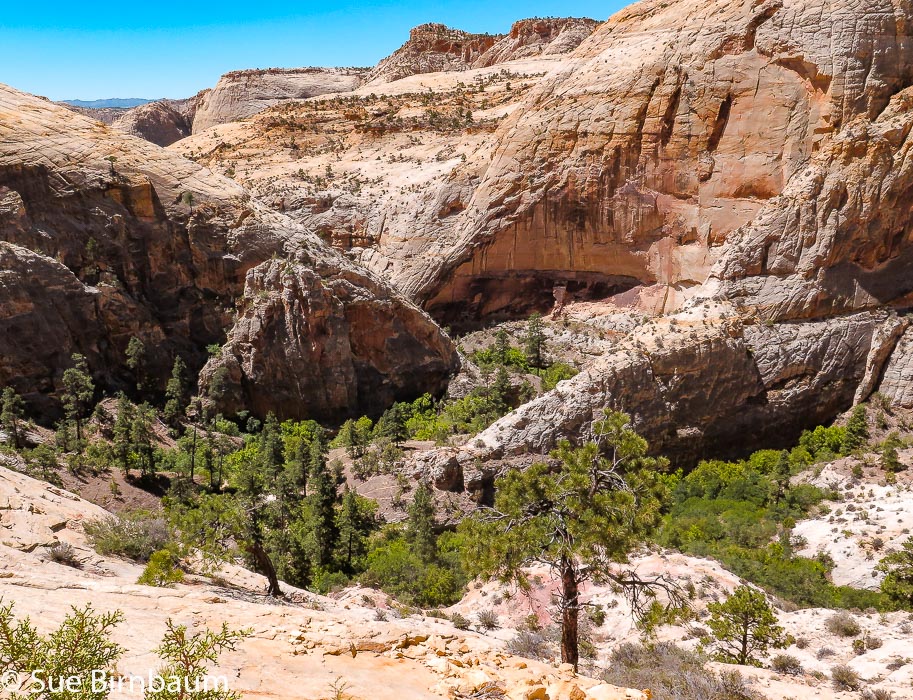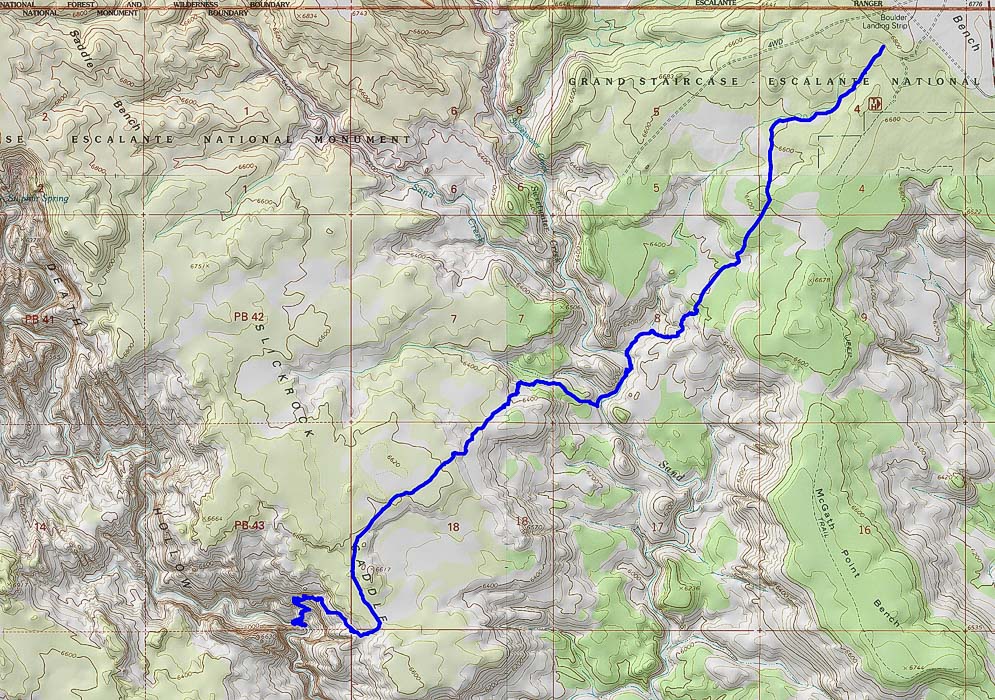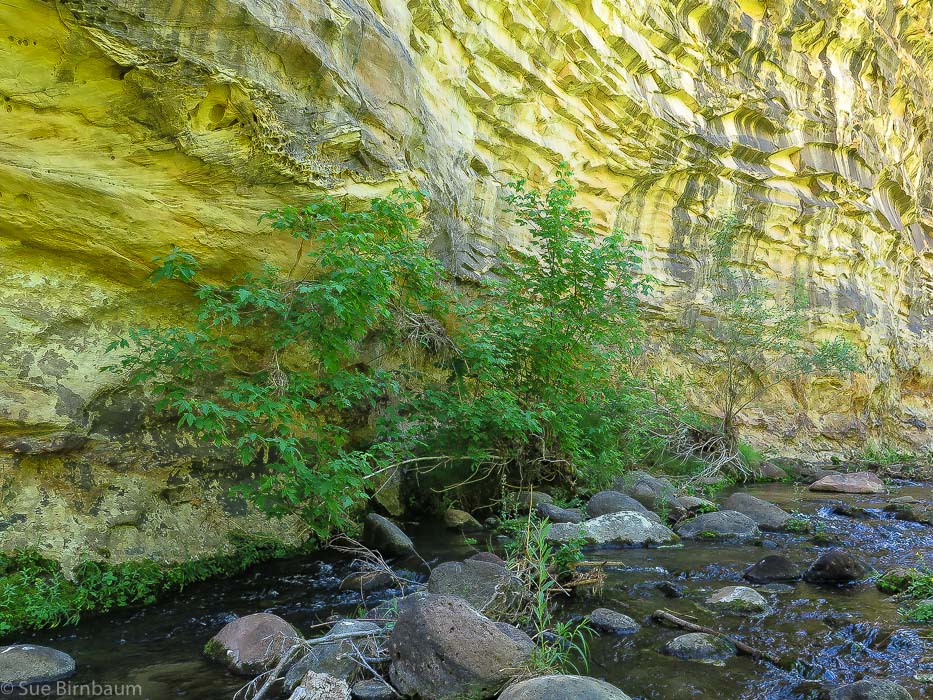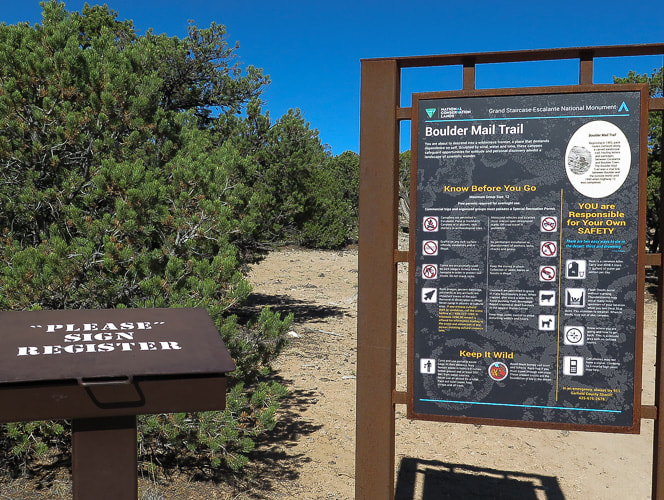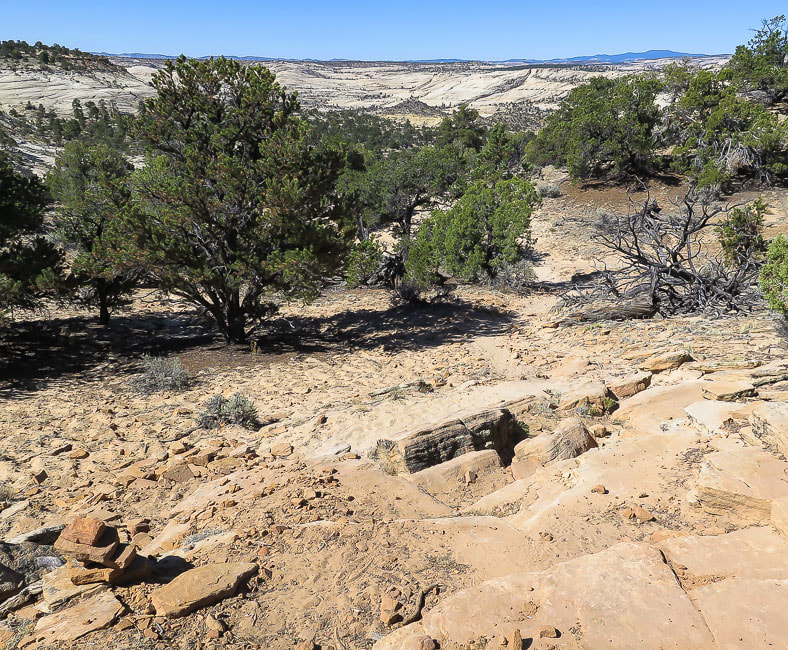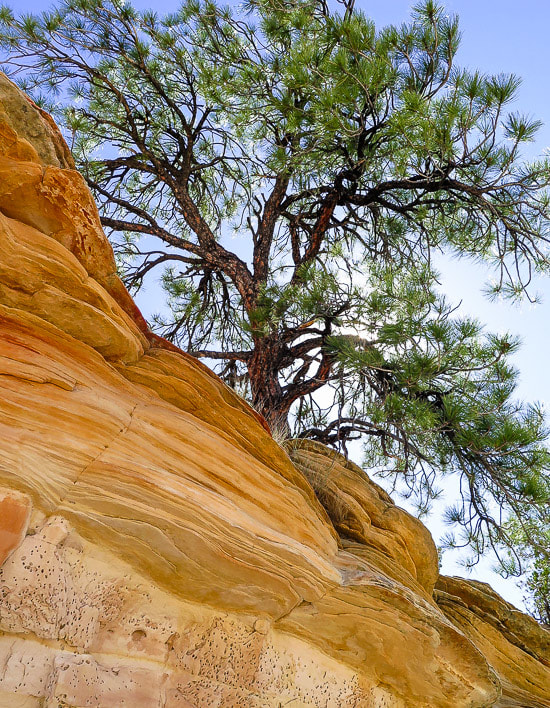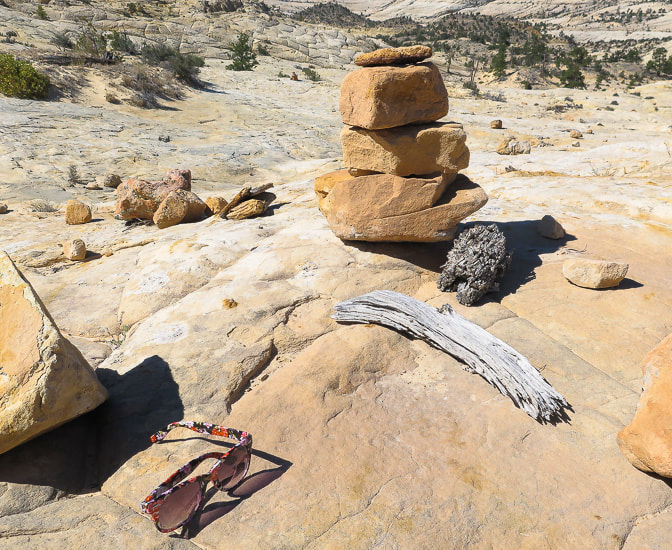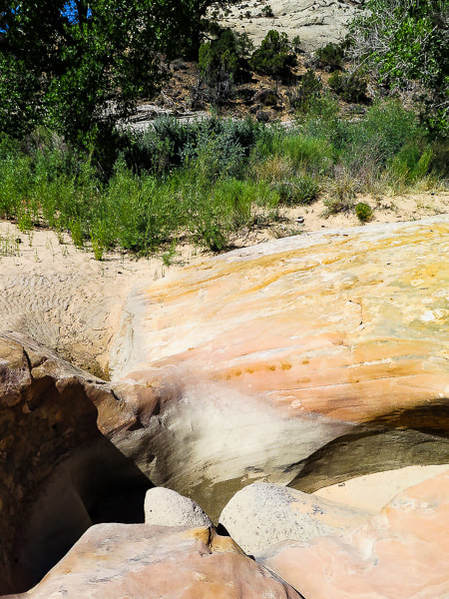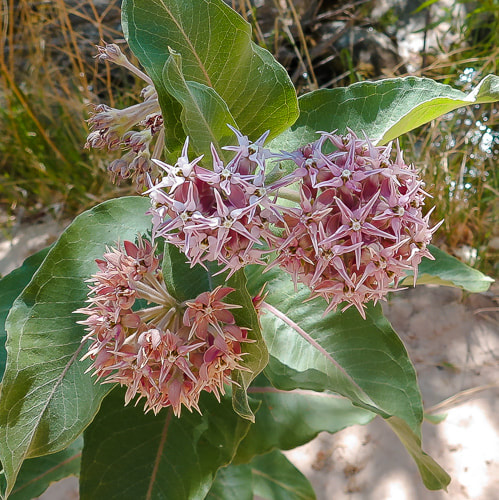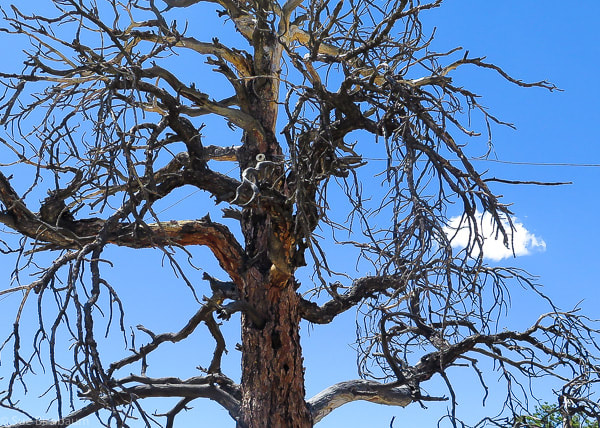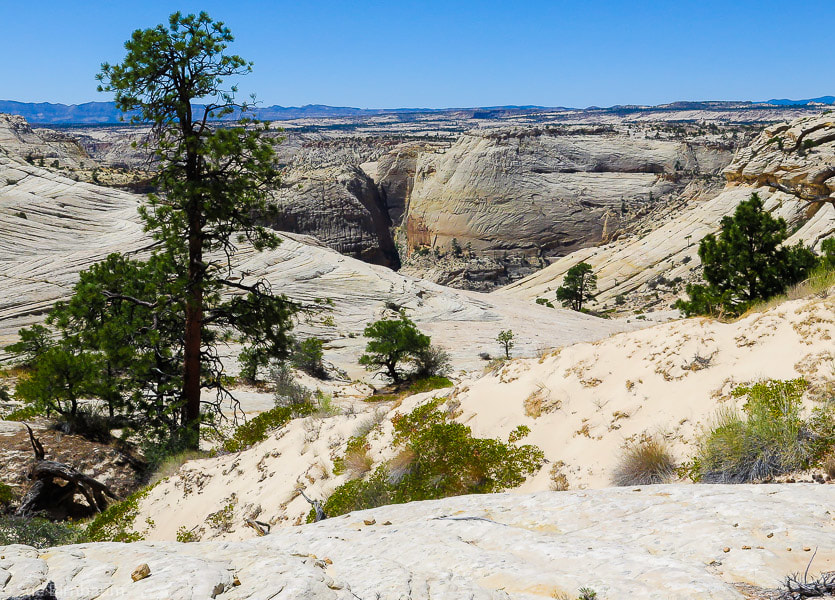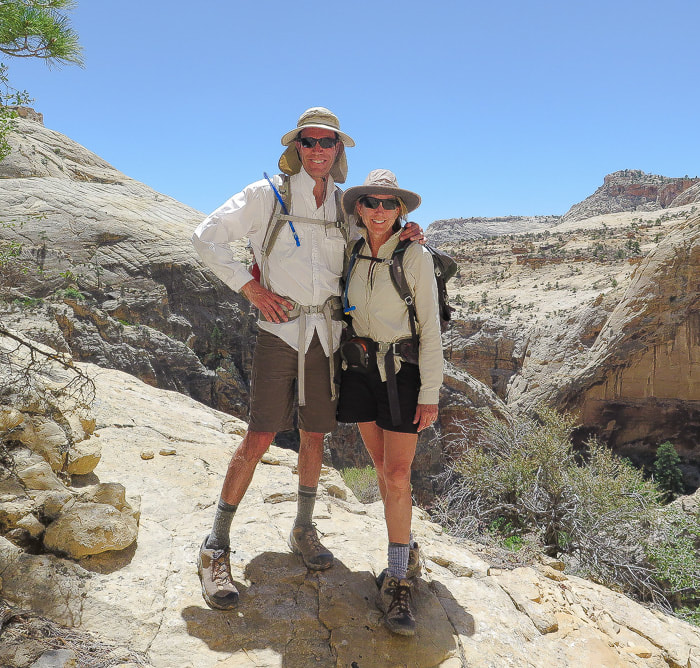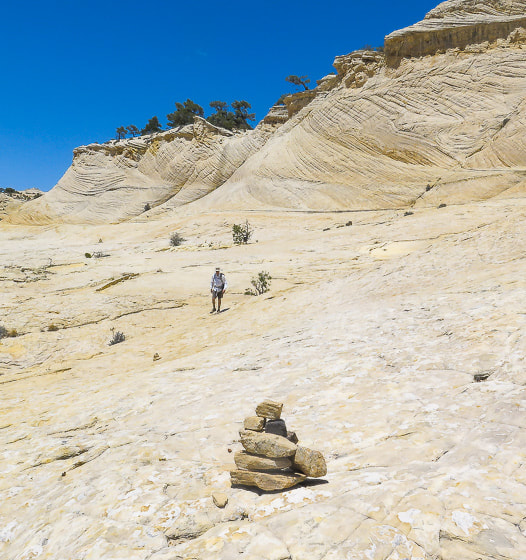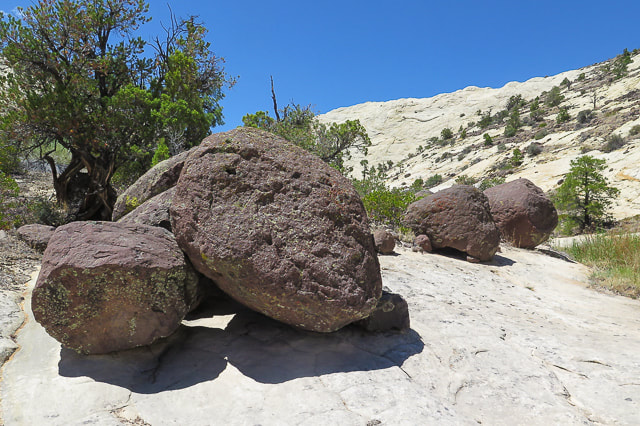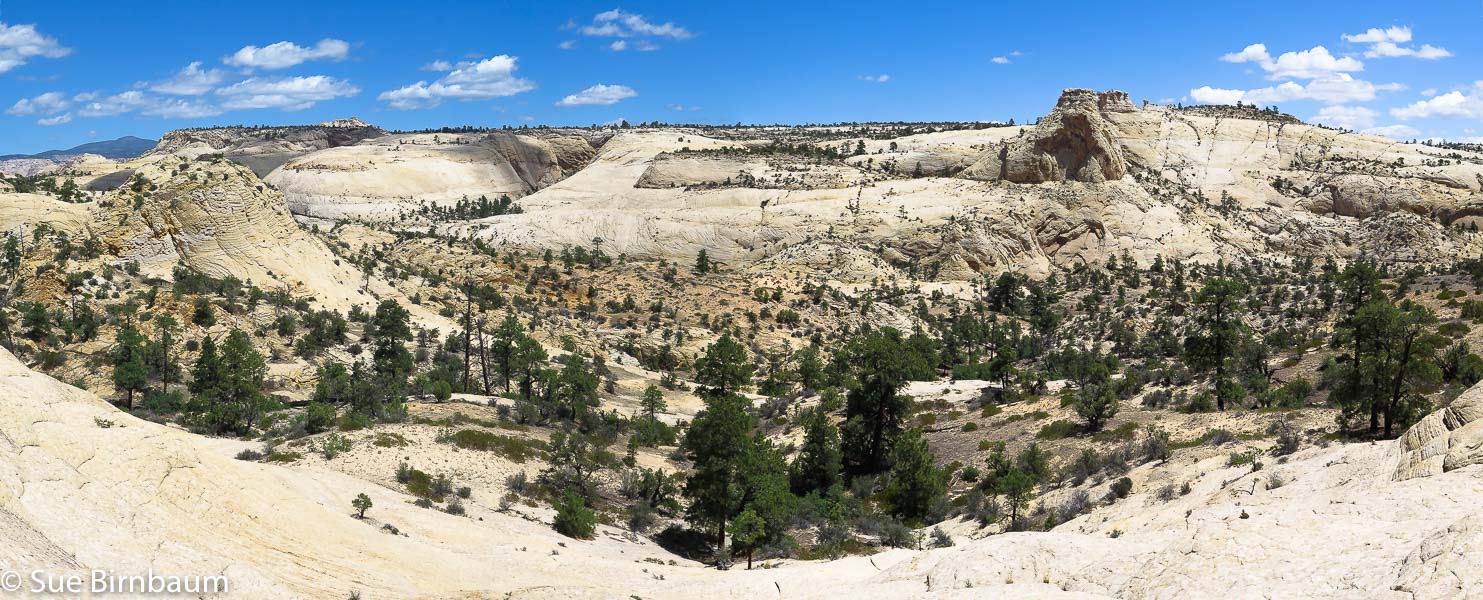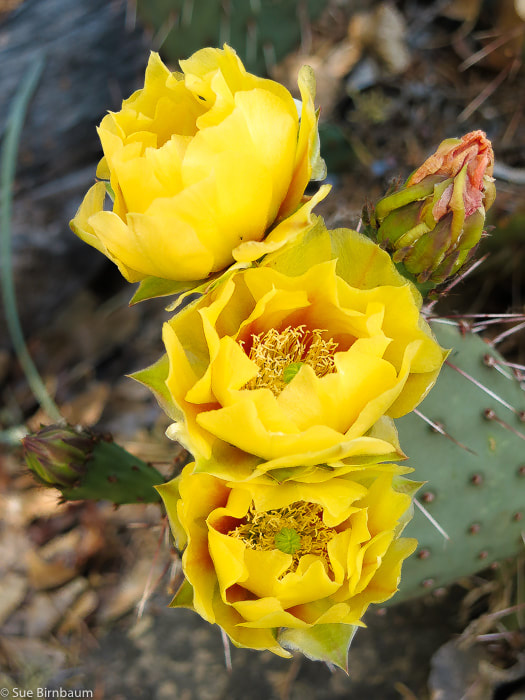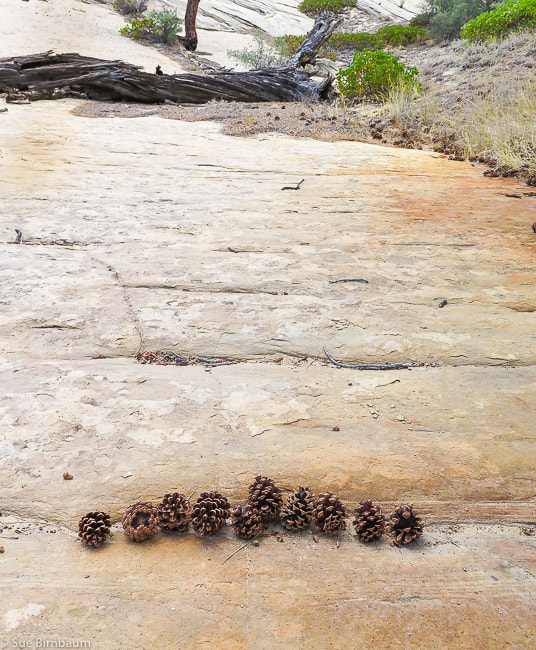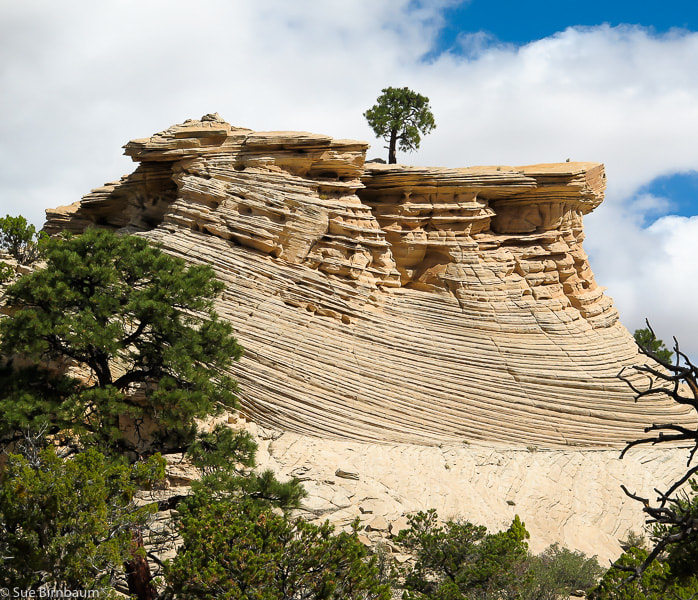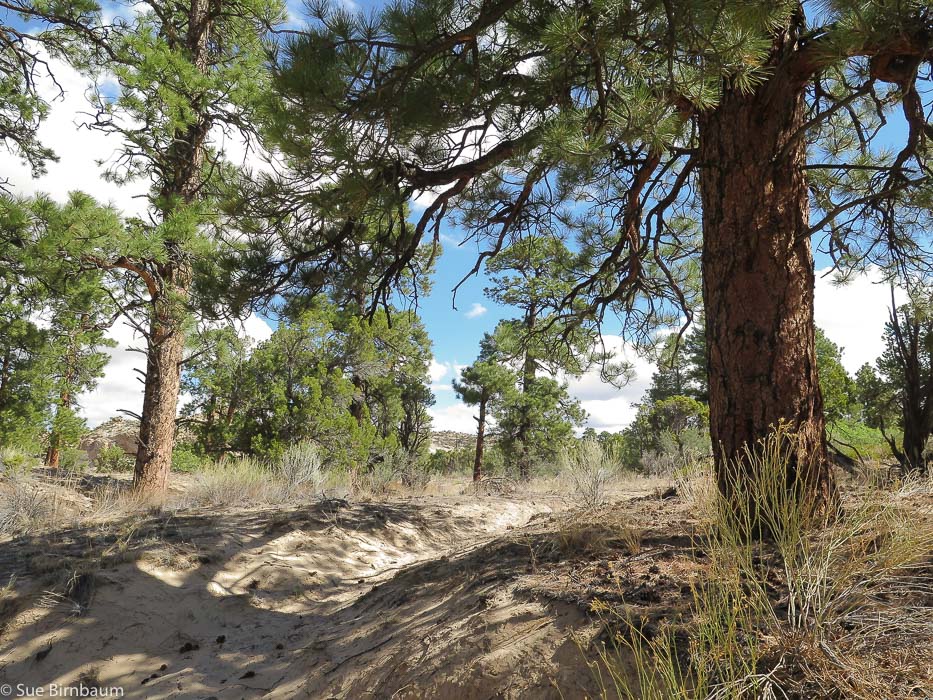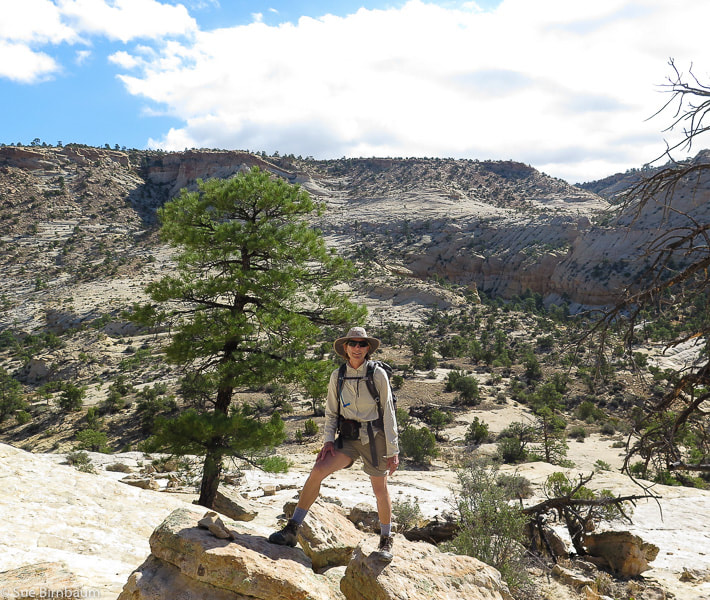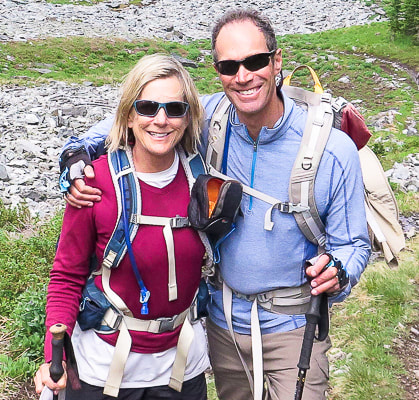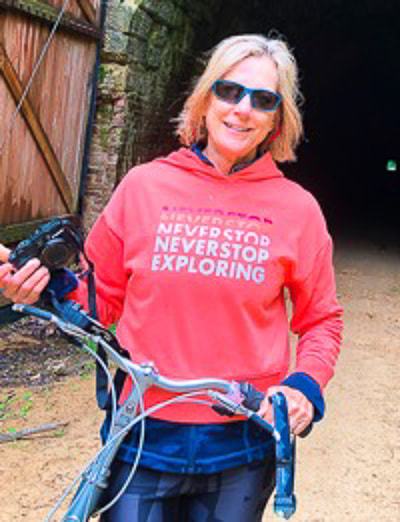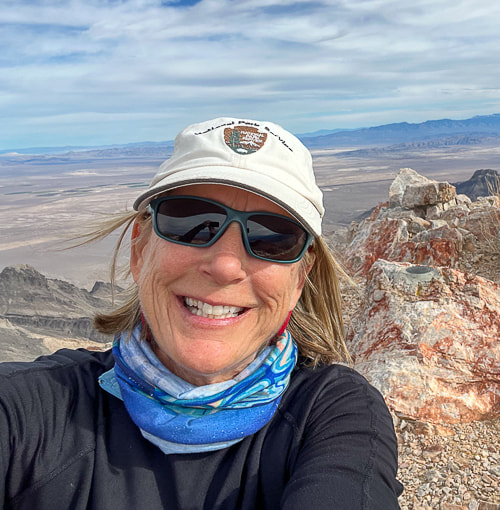|
Hike the remote cross-country route of the last mule U.S. mail delivery in the Phipps Death Hollow Wilderness Study Area through slickrock sandstone and sagebrush flats Descending into Death Hollow from northern route of Old Boulder Mail Trail Cross Country Route Trip Stats:
"If ever monuments are erected to unsung heroes, probably the tallest should be for those who brought the mail." - Nethella Woolsey, Escalante historian Northern section of Old Boulder Mail Trail Cross Country Route travels southwest from trailhead near Boulder Landing Strip to Death Hollow. This trail descends to Sand Creek, climbs to Slickrock Saddle, then descends again to Death Hollow. Our Adventure It was the vivid colors in Death Hollow that I remember most when Fred and I hiked the Boulder Mail Trail 18 years ago. Bright blue skies, red rounded rocks, orange and yellow cut walls, verdant willows: the whole scene reminded me of the hues on the art class color wheel. We saw only two other people on the trail that day - two guys swimming and splashing joyfully under steep walls. So extraordinarily different this hollow was from other streams I had hiked before whose colors, albeit beautiful, are usually various shades of brown, grey and green. Here, in the middle of an immense sandstone sea, we had color combinations only the desert can produce. On a very warm day in June this year, Fred and I hiked this trail again. The sandstone wall of Death Hollow as the Boulder Mail Trail enters it from the north is bright yellow and grey. I wondered if that rock surface could really be that colorful, and checked the colors of vegetation in the images I was taking. Maybe it was a reflection of the sun? Sandstones can be yellow due to dissolving of calcium carbonate, a common cementing material. The grey vertical stripes looked like weathering stains to me. Death Hollow where Boulder Mail Trail enters from the north These days, the Boulder Mail Trail trailhead is generously marked. The first 1.5 miles trek steadily down a bench through a pinyon/juniper/sagebrush forest. Views suddenly open up as the trail drops down into sandstone hills and gulches of the Sand Creek tributaries. Rock cairns mark the trail for the remaining trek to Death Hollow (and then on to Escalante), except for a few sandy stretches where the trail is marked initially by a cairn. Boulder Mail Trail trailhead sign and register Nearing transition from plateau to shallow Navajo Sandstone canyon. Look at that marvelous open country in the distance that we get to walk through! The trail zig-zags through a sandy opening of a shelf of eroded orange sandstone layers and deposits you onto the immense slickrock. As you leave the plateau behind, two and even three cairns can be seen ahead, linking the trail to Sand Creek. So much to see in such a stark landscape: grey lichen, aged wood, sand pockets, and water-smoothed channels. You never know what you may find on slickrock At 2.7 miles, cross Sand Creek, flowing in mid-June. Walk on right (west) side of creek through willows for ~ 0.2 - 0.3 miles to cairns that climb out of creek bottom and briefly switchback over a knob. We had to backtrack here because we followed the creek too closely to the shore. The climb from Sand Creek to the highest point on Slickrock Saddle is ~ 500 feet. The initial climb out of the creek is steep, then alternates between less steep and steep rises (see profile chart, above), trekking around the northwest side of a large dome with hoodoos on top. Telephone wire installed 108 years ago runs along the trail as it treks through long stretches of deep sand in a pinyon/juniper forest. This segment leads to the summit of Slickrock Saddle Bench at 6,600 feet and the first view of Death Hollow. Telephone line installed in 1910 runs along trail - insulators attached to trees like this one above in a dead Ponderosa Pine First view of Death Hollow from top of Slickrock Saddle Bench - last bit of sand hiking in foreground As you make your way off Slickrock Saddle Bench, the shadowy chasm of Death Hollow becomes deeper and deeper; you know it's there, but it just won't reveal itself right away. It's tempting to stare in awe at this unique sight, but stay focused on the cairns, too, because the trail swings south and skirts around a knob at 6,617 feet, heading for the best way off the bench. Next, the trail switchbacks and treks in a northwest direction. The steepest part lies ahead, and you wonder how mules delivering mail in the early 1900's walked across this precarious descent. A passage from the book "Advised them to Call the Place Escalante" reads: "To a reader sitting in a comfortable arm chair it is hard to describe the beauty of the Death Hollow Trail or the fear caused while sitting astride a horse trying to make its way safely over the rough terrain. It is said that horses' legs literally quivered as they gingerly picked their way down the trail." - Jerry C. Roundy, Escalante resident and author of "Advised them to Call the Place Escalante" This trail was known in the early 1900's as the Death Hollow Trail, and it was the shortest route between Boulder and Escalante. It was the fastest route if one was in a hurry, for the wagon road between the towns was a longer distance. Parts of this trail were "blasted out" in order for safe horse passage. Tales of cream cans and eggs being delivered via the Death Hollow Trail among other trail experiences are described in Jerry Roundy's book. The residents of Boulder and Escalante finally received the mail service they had been petitioning for in 1902 when the first government mail carrier's contract was given to an Escalante resident, who would deliver mail using the Death Hollow Trail twice per week. I'm more aware of my balance on the steep slickrock; most of the texture of the rock enables my boots to grip well, but there are smoother patches to look out for. I imagine what it was like to lead horses and mules over this section. Did they slip? During the winter was there ice? What would this place look like with several inches of snow? Or under a full moon? I believe the Death Hollow Trail mail carriers were pretty tough, and they got to see some of the most beautiful scenery in the world. Starting at ~ 5.25 miles, the well-marked trail switchbacks and descends 600 feet in 3/4 of a mile to the thick vegetation of the flowing creek in Death Hollow. Some moss-covered rocks were slippery to step onto. There's a sweet tent spot at the terminus, and from the paths seen on the treeless part of the shore on the descent, there are probably more tent spaces available. This time we didn't hike down Death Hollow as we did 18 years ago, although the water would have cooled us off in the mid-80's temperature. Vegetation along water seemed thicker this time, but the colors and textures no less beautiful. The cool shade, chatter of water over rocks, sudden splash of colors and tall vertical walls in Death Hollow contrast with the bright and open, mostly shadeless trek across sandstone country. After resting in the shade, we started the 6-mile hike back, looking forward to the largest elevation gain of the trip - 1,450 feet. On the way back, we took a break at Sand Creek, near huge rounded basalt boulders, probably from Boulder Mountain, whose basalt age is 6 - 16 Ma, and whose run-off streams provide water for Sand Creek. There's always numerous adventures awaiting me, and seeing Fred walk across the slickrock is even more fulfilling than the hike, which is hard to beat. One of the best parts of life is the hope of future adventures in the beautiful American West. Next time - the entire Boulder Mail Trail! Two days earlier, Fred and I hiked from Escalante to Mamie Creek along the Boulder Mail Trail (the southern portion). Although we didn't get all the way to Death Hollow, I feel that portion of the trail is even more gorgeous. We had the Phipps Death Hollow Wilderness all to ourselves that day, as we saw no one else. It's days like these that I will remember reverently - forever. Below are some images of the portion of the Boulder Mail Trail Cross Country Route south of Death Hollow. We ran into a retired biologist who took this photo of us after a detailed discussion of Fe+3, ferric iron in the rocks - very interesting to me, but Fred not so much! Thank goodness for cairns! Slickrock Saddle Bench Basalt boulders near Sand Creek Images from south portion of Boulder Mail Trail Cross Country Route - Escalante to Mamie Creek Prickly pear near junction of Pine Creek and Old Boulder Mail Trail Heading up to Antone Flat South end of Boulder Mail Trail from Escalante trailhead Trail goes to the left of large drainage and then treks to the right in this photo on the smooth portion at the base of plateau References:
Boggs, S. Jr. 2012. Principles of Sedimentology and Stratigraphy, Fifth Ed. Pearson Education, Inc. Hackman, R.J., and Wyant, D.G., 1973, Geology, structure, and uranium deposits of the Escalante quadrangle, Utah and Arizona: U.S. Geological Survey, Miscellaneous Geologic Investigations Map I-744, scale 1:250,000. Parry, W. T. 2016. Geology of Utah's Mountain, Peaks and Plateaus. Friesen Press, Victoria, B.C., Canada. Roundy, J. C. 2000. "Advised them to Call the Place Escalante". Art City Publishing, Springville, Utah. 355 pp. UtahGeology.com. http://utahgeology.com/bin/formationdescs.php?fm=fm_navajo.
6 Comments
9/4/2018 08:37:21 am
Sue, I love your descriptions of this rugged landscape. You are my virtual senses as this is not an area I would be likely to explore. You show me, in vivid detail, what I'm missing.
Reply
Linda!
Reply
Valerie Estabrook
9/16/2018 03:49:08 pm
So very interesting, both the photos and your detailed descriptions! I felt like I was actually on the trail! Would love to do this one in the near future. Thanks for sharing this one Sue!
Reply
Thanks Val!
Reply
1/3/2019 01:08:43 am
I guess, this is one of the best adventures you had so far! Old Boulder Mail Trail Cross Country Route looks a bit creepy because it's too big. Once you get lost or trapped, it's quite impossible for you to be found. In my case, I just have to accept my fate because I wouldn't survive it. I watched a movie that features a hiker who got trapped while he was on his trail. it was based on a real story so I don't know actually how he overcome it after being trapped for almost a couple of days! But he managed to survive despite hundreds of circumstances that he wouldn't!
Reply
Thanks for your comment!
Reply
Leave a Reply. |
Categories
All
About this blogExploration documentaries – "explorumentaries" list trip stats and highlights of each hike or bike ride, often with some interesting history or geology. Years ago, I wrote these for friends and family to let them know what my husband, Fred and I were up to on weekends, and also to showcase the incredible land of the west.
To Subscribe to Explorumentary adventure blog and receive new posts by email:Happy Summer!
About the Author
|
